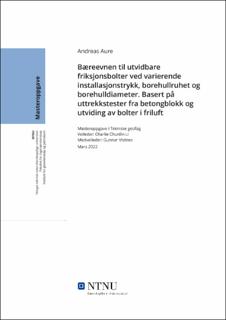| dc.contributor.advisor | Li, Charlie Chunlin | |
| dc.contributor.advisor | Vistnes, Gunnar | |
| dc.contributor.author | Aure, Andreas | |
| dc.date.accessioned | 2022-07-05T17:22:19Z | |
| dc.date.available | 2022-07-05T17:22:19Z | |
| dc.date.issued | 2022 | |
| dc.identifier | no.ntnu:inspera:98445220:20907797 | |
| dc.identifier.uri | https://hdl.handle.net/11250/3002919 | |
| dc.description.abstract | 18 uttrekkstester ble utført på utvidbare friksjonsbolter installert i en betongblokk. Boltene er av Swellex-typen som installeres med vanntrykk, og ikke behøver mørtel eller polyester. Ved uttrekkstestene ble deformasjonen og boltens bæreevne målt kontinuerlig. Formålet med testene var å observere hvordan bæreevnen påvirkes av ulike installasjonsvariabler, og å sammenligne dette med eksisterende analytiske teorier. Variablene som ble undersøkt var installasjonstrykk, borehullruhet og borehulldiameter.
Ved å benytte et pumpetrykk på 24 MPa og 30 MPa viste uttrekkstestene at et økende vanntrykk ved installasjon ga en økende bæreevne. Fra 30 MPa til 24 MPa falt bæreevnen med 20%. For berg av en tilsvarende hardhet stemmer dette godt overens med eksisterende analytisk teori og tidligere testerfaring.
Ved å benytte både diamantbor og slagbor til boring av boltehullene ble bæreevne målt mot overflateruhet i hullveggen. Hullene boret med slagbor hadde en høyere ruhet og ga høyere bæreevner for alle de benyttede hulldiameterne. Fra slagbor til diamantbor falt bæreevnen med mellom 37% og 43%. Dette samsvarer med den analytiske modellen som også angir økende bæreevne ved økende ruhet.
Ved å benytte tre ulike borehulldiametere ble boltens bæreevne og primære kontaktspenning målt mot boltens utfoldingsgrad. De to største diameterne i det anbefalte spekteret viste en økende bæreevne ved økende borehulldiameter. Fra 37 mm til 33 mm falt bæreevnen med mellom 28% og 42%. Dette sammenfaller med de teoretiske antagelsene og tidligere testing. Derimot ga den minste diameteren en høyere bæreevne enn den midterste. Dette oppsto trolig da boltens tunge, som gir en lav radiell stivhet, her var lukket og dermed ikke bidro til å svekke bolten.
Åtte bolter ble utvidet i friluft uten begrensning fra et omkransende borehull. Ved å måle den elastiske deformasjonen under på- og avlastning ble den radielle stivheten til bolten estimert. Testene ga mot forventning en hovedsakelig synkende stivhet ved økende boltomkrets. Det benyttede testoppsettet dømmes lite egnet til å observere den forventede økte radielle stivheten ved semisirkulær og sirkulær tverrsnittform. | |
| dc.description.abstract | 18 pull-out tests were done on expandable friction rockbolts installed in a concrete block. The bolts are of the Swellex type that is installed with pressurised water and has no need for a grouting agent. During the pull-out tests the load and displacement were measured throughout. The purpose of the testing was to observe how the ultimate load of the bolt is affected by different installation variables, and to compare the results with existing analytical theories. The variables in question were installation pressure, borehole roughness, and borehole diameter.
By using a pump pressure of 24 MPa and 30MPa the pull-out tests showed that increasing the water pressure during installation increased the ultimate load of the bolt. From 30 MPa to 24 MPa the ultimate load decreased with 20% on average. This is compatible with existing analytical theories and previous results for a rock mass of similar quality.
By using both a diamond core drill and a pneumatic hammer drill the ultimate load was compared to the roughness of the borehole wall. The hammer drilled holes had a higher roughness and gave a higher ultimate load for all the hole diameters. From hammer drilling to diamond core drilling the ultimate load decreased with 37% to 42%. This is in line with the analytical model which proposes that an increase in borehole roughness will give an increase in ultimate load.
By using three different borehole diameters the primary contact stress and general load capacity was compared to the unfolding degree of the bolt. The two larger diameters were in the recommended range and showed an increase in ultimate load with an increasing borehole diameter. From 37 mm to 33 mm the ultimate load decreased with 28% to 42%. This is in line with previous results and the analytical model. However, the smallest diameter resulted in a higher ultimate load than that of the middle diameter. This likely occurred as a result of the bolt tongue, that usually provides a low radial stiffness, in this case being closed and therefore not weakening the bolt.
Eight bolts were expanded in free air with no surrounding borehole. By measuring the elastic displacement during loading and unloading cycles the radial stiffness of the bolt was estimated. Counter to expectations the tests gave a mostly decreasing stiffness with increasing borehole size. The utilized test setup is judged to be unsuitable to observe the expected increase in radial stiffness accompanying bolts with semi-circular and circular cross sections. | |
| dc.language | nob | |
| dc.publisher | NTNU | |
| dc.title | Bæreevnen til utvidbare friksjonsbolter ved varierende installasjonstrykk, borehullruhet og borehulldiameter. Basert på uttrekkstester fra betongblokk og utviding av bolter i friluft | |
| dc.type | Master thesis | |
